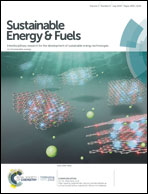Study on catalyst selection for electrochemical valorization of glycerol
Abstract
The recent tremendous growth of biodiesel production from vegetable oils or waste fats has led to increased glycerol accumulation as a by-product of this process. This sparked attention towards glycerol use and valorization of this largely available and cheap compound. A number of high value-added chemicals could be produced from glycerol via different catalytic processes, ranging from heavy metal complexing agents to drug delivery agents or polymer precursors. Among several routes for glycerol valorization, the electrochemical one appears to be a very attractive process that can generate a number of high purity value-added chemicals. Furthermore, the glycerol electrooxidation reaction (GEOR) at the anode can be coupled with cathodic hydrogen production or CO2 electroreduction in an electrolytic cell. The control of catalytic activity and selectivity is influenced by the nature, structure and composition of the electrode material, which can be tuned by various synthesis approaches. This review provides a comprehensive summary and critical analysis on glycerol electrochemical oxidation research during the last five years. The main emphasize is made on catalyst selection, design and characterization for application in the GEOR. In particular, the recent development and prospects of using non-platinum group metal catalysts for glycerol electrooxidation are discussed. Reaction product selectivity analysis using spectroscopic and analytical techniques is outlined. In addition, recent theoretical developments, based on density functional theory (DFT) calculations, are addressed as a tool for guiding the catalyst design with bespoke reaction selectivity and catalytic activity properties. Finally, the remaining challenges and prospects are also highlighted.



 Please wait while we load your content...
Please wait while we load your content...